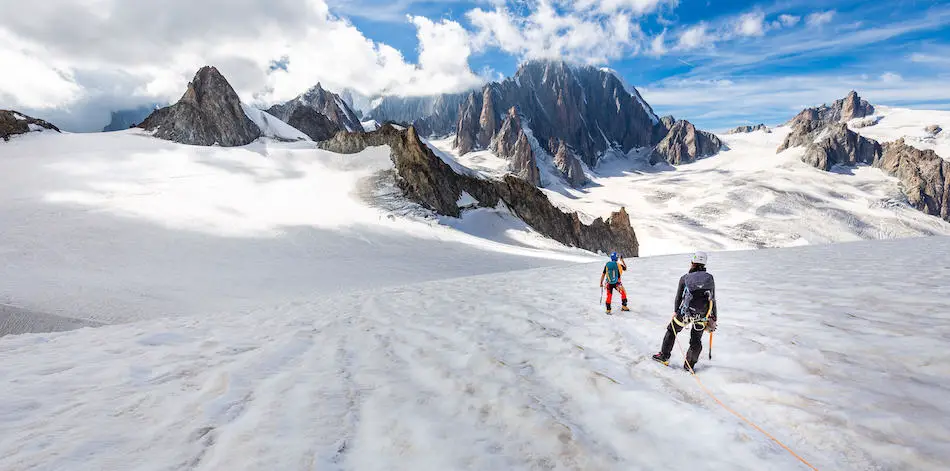
There’s very little information online about what ropes are okay to use for glacier travel. I decided to rectify that situation.
So, what rope should you use for glacier travel? When traveling on a glacier, you can use any static or dynamic rope that’s at least 7.8mm wide and 30 meters long. The best ropes for glacier travel are:
- The Beal Rando 8mm
- The Petzl RAD Line
- The Sterling 7.8mm Photon
- The Mammut 8.7mm Alpine
There are a lot of factors that you need to consider when picking a rope for glacier travel. How long does it have to be? How thick? Can you use a twin rope? Should it be static or dynamic? Will you be using it to lead any pitches, or are you just clipping in to protect from a glacier fall? In the following guide, I review all of these questions in detail, before talking about my 4 personal recommendations for the best rope for glacier travel.
Choosing a Rope for Glacier Travel
So, before we get into the specifics as to what the best ropes are for glacier travel, let’s talk about the general criteria you need to fulfill before you can use a rope for this purpose.
When crossing a glacier, your rope is there to catch you if you fall into any crevasses (a crevasse is a hole in the glacier that can be hundreds of feet deep). You and your climbing partners tie into the same piece of rope and then walk at least 20 meters apart from each other.
The point of this set up is so that if one of you falls into a crevasse, the other person can arrest them using the rope, before hauling them back to safety.
To do this, obviously, you need to have the right rope.
It needs to be long enough to allow for effective crevasse rescue, without being so long that it weighs you down or gets in the way. It needs to be strong enough to hold the weight of a falling climber without becoming a burden. Depending on what route you’re on and what gear you’re carrying, it may also need to serve as a lead rope or a rappelling line.
Before we can talk about the ropes specifically, it’s important to understand, in detail, what functions you’ll need from it.
What You Use It For
So, what are glacier ropes used for?
Catching
As I said, the main function of roping up when walking across a glacier is to catch you if you happen to fall in a crevasse. Crevasses are thin fissures in the body of the glacier— cracks of ice that form as the glacier moves and can go down hundreds of feet. If you fall into one of these, there’s a good chance you’ll never make it out.
Many crevasses are covered in a thin layer of snow, too, making them almost impossible to see. One minute you think you’re walking along on solid ground, and the next minute the ground beneath your feet has disappeared and you’re falling.
When this happens (because it’s an if, not a when), you’ll want your rope to be strong enough to catch your fall. For this, I would recommend using a single or half rope that’s at least 7.8mm ride.
Crevasse Rescue

When you do fall into a crevasse, you’re going to rely on your rope to get you out of it.
There are a few functions that you need for the rope to serve this purpose. First of all, it needs to be strong enough to hold your weight while you’re being hauled out.
Secondly, it needs to be wide enough to work with most belay devices. Pulling a human being out of a crevasse is hard work, and the friction-creating mechanism within a belay device can help make the process easier. To be effective, though, the rope needs to be able to create friction in the device for this to be effective.
Finally, you need to worry about the dynamic functions of the rope. Static line is better for hauling with, and it will make it easier to pull someone out of a glacier. This is a hotly-contested topic in the climbing community, and we’ll get to it later.
Other Alpine Functions
As with most things in mountaineering, you rarely have a piece of equipment that’s only going to fulfill one roll.
Most people who are walking across a glacier are doing it to get somewhere, be that an interesting ridge, a frozen waterfall, or a hard-to-reach summit. Sometimes, this terrain will be dangerous that you’ll want to rope up to prevent a fall. This means that rope needs to be good not just for glacier travel, but also for leading alpine routes.
In such a case, you would obviously want a dynamic rope, and most likely one that’s at least 60 meters long. Of course, you could always bring a glacier rope and a climbing rope, but that can add a lot of extra weight to your packs.
Judgement Criteria
Now that we know about what you’re planning to use your rope for, let’s get into the criteria I used to judge the following ropes on.
Weight
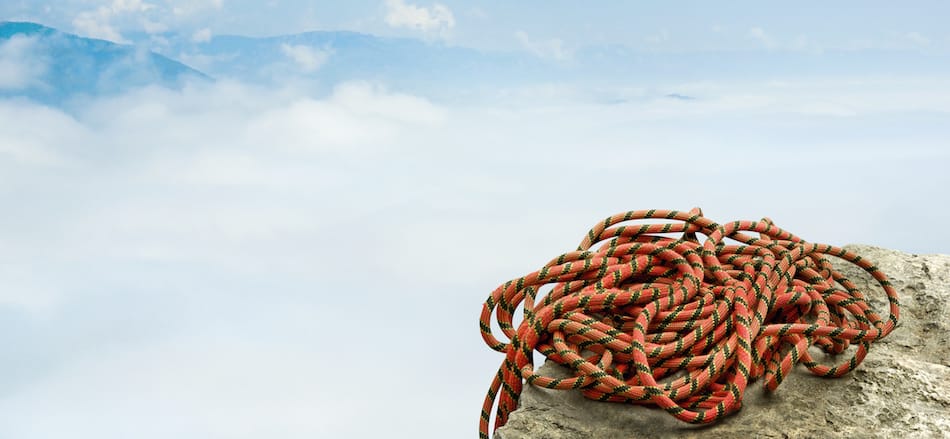
Weight is an important criterion when it comes to finding a rope. Hauling 40 pounds of gear up an alpine route can wear out your legs, which ruins your enjoyment of the climb and can put you in danger.
Essentially, in just about any scenario, the lighter rope will serve you better. However, there’s a limit to this rule; the rope needs to have a few other key criteria to be met:
- It must be wide enough (7.8mm or higher): Cutting a lot of weight is no good if the rope isn’t wide enough to catch you. Any rope less than 7.8mm isn’t rated strong enough to be trusted to catch a glacier fall.
- It must be dry treated and have a durable enough sheath: Again, sometimes you need to sacrifice weight in exchange for function. Being dry treated is an essential if you’re walking through ice-and-snow-covered environments. The durable sheath can extend the lifetime of the rope, and will stop it from getting damaged if it’s being dragged along the lip of a crevasse.
- It must be at least 30 meters long: Obviously, the shorter your rope, the less weight it will have. However, past a certain point, the rope becomes too short to properly protect you.
Length
That brings us right to our next point, which is length. Length is another important thing to keep in mind when selecting your rope.
Glacier travel ropes should be at least 30 meters long, but 40-50 meters is better.
Now, obviously, the shorter your rope, the less it will weigh and the easier it will be to work with. However, having a short rope comes with significant disadvantages of its own:
- It limits your ability to use it when climbing
- You won’t be able to perform any significant rappels
- You have less maneuverability while on the glacier
- It can lower your margin of safety
I’m going to focus on the last two points, because this article is about glacier travel, not mountaineering in general. That being said, climbing and rappelling are important points to be considered, and your day is going to get a lot harder if you can only do things in 15-meter spurts.
First, let’s focus on the maneuverability aspect. The longer your rope, the more ability you have to work your way around the glacier, including any crevasses or obstacles that you might encounter. Very few problems will crop up if you have more rope to work with.
More important than that, however, is the element of safety. The more rope you have, the farther you can space yourself and your partner, which means the less chance that both of you fall into the same crevasse. Furthermore, there’s less chance that if one person falls in, they’ll pull the second one in with them.
Furthermore, having lots of rope with you means that you have some to spare to perform a crevasse rescue if need be.
At the beginning of this guide, I said that you need to have at least 30 meters of rope to safely travel on a glacier. That number is an absolute minimum to have enough distance between you and your partner for the travel to be safe.
The longer you make the rope, however, the safer you’re going to be. While 30 meters will work, you run the risk of having no spare rope to perform a rescue with if someone falls into a crevasse.
Essentially, this could leave you stranded on the glacier; one partner in the crevasse, the other anchoring them on the outside, and not enough rope to perform a rescue. This is slightly better than both of you falling into the crevasse, but unless you’re able to reach your SPOT/inReach, it’s still a pretty tight spot to be in.
So, when it comes to length, I would recommend spending the extra $20 that it’s going to cost you and buying the extra few meters of rope.
Single, Half, or Twin?
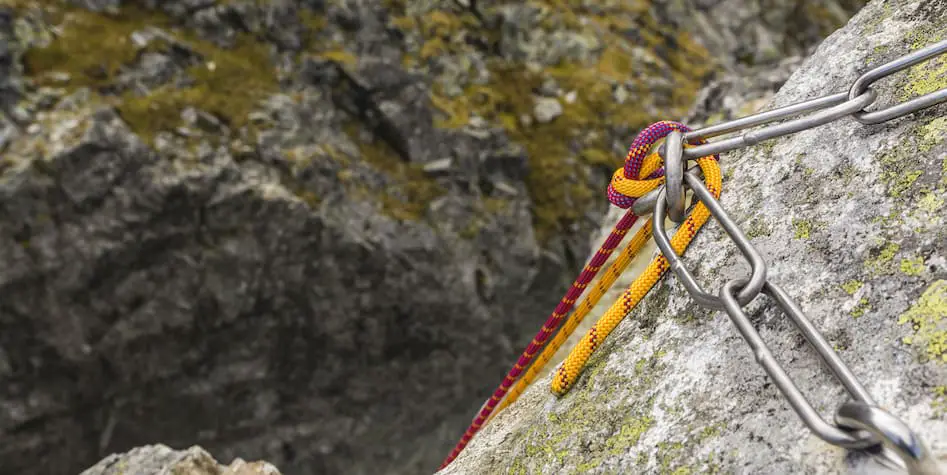
One more thing to consider is single, half, and twin ropes. I always find these terms confusing, so let’s do a quick review:
- A single rope is designed to be used by itself when belaying. It’s usually 8.5-11mm wide. This is the normal, standard rope that most rock climbers will use.
- A half rope is designed to be used with a second half rope when belaying. However, the ropes are allowed to be clipped independently through pieces of protection (e.g, you can clip one rope through the first bolt and then clip the second rope through the next bolt).
- A twin rope is one that’s designed to be used with another twin rope, except both ropes must be clipped through each piece of protection.
For glacier travel, you can use either a single rope, one half-rope, or one twin rope. These ropes are all weighted strong enough to stop a ‘sliding impact’, which is the type of fall that one will take on a glacier.
The upside of using a half or twin rope is that they tend to be lighter than a single, which saves you weight and energy. The downside, however, is that you probably won’t be able to belay with the rope, so it won’t function as an all-around device for technical mountaineering trips.
If, however, you just want something to bring with you for some moderate glaciers, a half rope or a twin rope can work just fine in that scenario.
However, it does stand to be said that when you go down in rope length, you are decreasing your margin of safety. A half rope will be riskier than a single rope. A twin rope will be even risker than a half rope.
These ropes are manufacturer-tested and are rated for this purpose, but always make your own decisions and only do what you’re comfortable with.
Dynamic vs Static Ropes
I’m going to make the same joke that I make whenever I write about ropes: this is the section where I start to lose some fans.
The debate as to whether or not you can take a static rope onto a glacier is hotly contested within the climbing community. Prior to writing this post, I spent hours searching through climbing forums, looking for a definitive answer.
The opinions that I found ranged from, “it’s not only possible, it’s better” to, “if you bring a static rope onto a glacier, both you and your partner will die a gruesome death”. Safe to say, there’s a divide (dare I say, a crevasse?).
The debate essentially boiled down to two arguements:
Theory 1 (Static ropes should not be used): If one person falls on a glacier, a static rope will pull against the second person much more quickly, because it doesn’t stretch. This allows the second person less time to prepare to arrest the first person’s fall, leading to a higher chance that both parties go tumbling into the glacier, never to be seen again.
This is countered by Theory 2 (in defense of static ropes): Static ropes still have a certain amount of give to them. The timing difference that one will have with a static vs dynamic rope isn’t that different. Furthermore, static ropes are easier for hauling, which makes it a better option for pulling your partner out of the crevasse.
I’m not going to settle it with this one post, but I might as well try. My answer is this: I agree with Theory 2. As long as you have enough rope and a proper tie-off system, using a static rope on a glacier is fine. In fact, it may even be preferable.
Don’t take my word for it, though! Check out Alpine Savvy for a list of sources confirming this.
So, with that debate settled, we’ve now talked about all the criteria you need to consider when roping up for a glacier. Without further ado, let’s move on to the best ropes for glacier travel.
Best All-Around: The Beal Rando 8mm
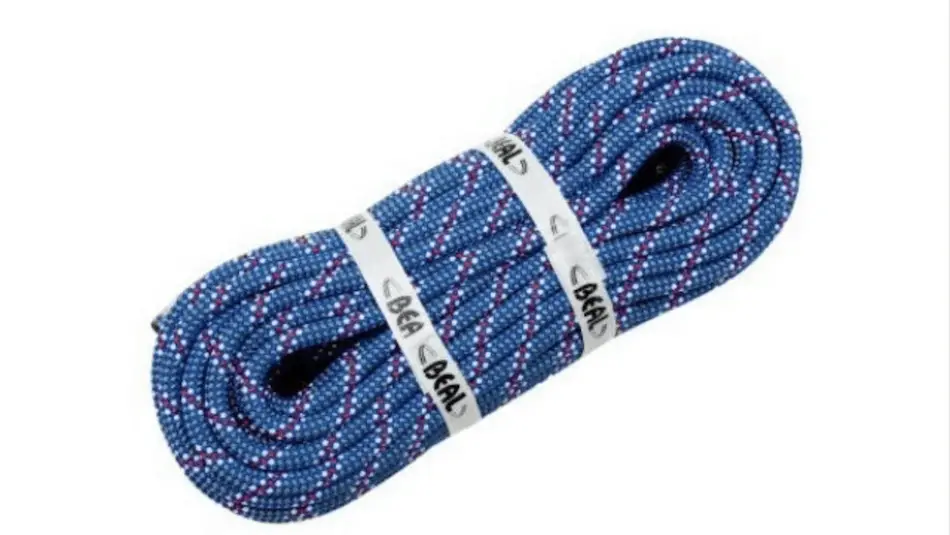
Price: $187.50 per 60 meters
Pros:
- Designed for glacier travel
- 48-meter length allows you margin of safety without creating excess rope
- Special sharp-edge sheath protects against sharp rocks or ice formations
Cons:
- Narrower design can be tough to use with some belay devices
Verdict
Sometimes, you find a tool so perfect for the job that the review basically writes itself.
When it comes to glacier ropes, the Beal Rando 8mm is that tool. This semi-static, 48-meter-long half rope is designed for glacier travel and ski mountaineering. It’s got every feature you could want for a glacier crossing rope, and none that you don’t.
To start, it’s the perfect length at 48 meters, giving you just enough rope to play out some extra slack while still leaving enough coiled to perform a rescue. It’s light, coming in at 37 grams per meter, so you’ll barely feel it in your pack.
Finally, it’s got a dry treated- abrasion-resistant sheath that protects the rope from any scraping or scratching that might occur. That means you don’t have to worry about it sliding against sharp crevasse lips.
It’s important to mention that this rope is a specialist in perhaps the strictest sense of the word. It’s designed for glacier travel, and only glacier travel. You can’t lead with it, and you can’t trust it to take any kind of dynamic fall. It would function for rappelling, but other than that, it won’t do too much in an alpine environment.
Keep in mind, though, this list is about glacier travel. If all you need to do is cross a few kilometers without falling into a crevasse, this is the rope for you.
If there’s one downside to the rope, it’s that it’s narrower than most traditional ropes, although that downside could be said of all of the other ropes on this list. As long as you practice beforehand and you know it will fit your belay device, this shouldn’t be an issue.
Runner Ups
These next two ropes didn’t quite do enough to take the top spot, but they have some attributes of their own that make them worthy of mentioning.
The Petzl RAD Line
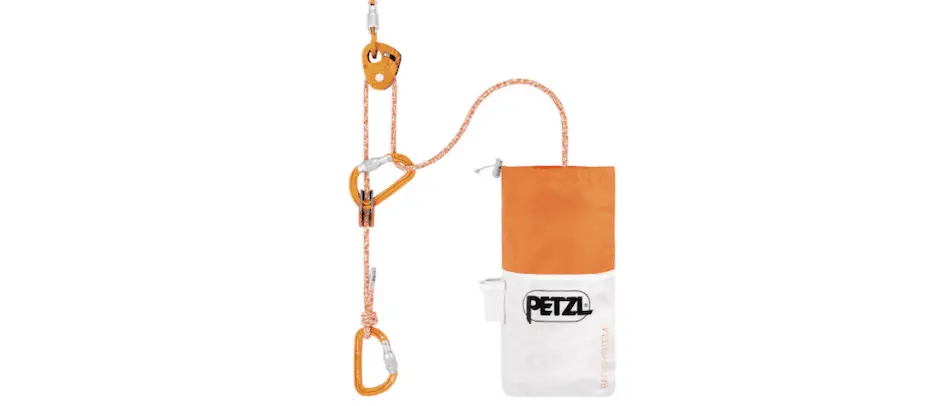
Price: $460 per 60 meters
Pros:
- Full-service kit for backcountry skiing, crevasse rescue, and glacier travel
- Highly specialized and designed for this
- Tools all come together in one kit
- Extremely lightweight
Cons:
- Expensive
- Specialized design may be overkill for some climbers
- Narrow rope is only compatible with a few ascenders
Verdict
The Petzl RAD Line came so close to taking the top spot on this list. Even as I’m writing this, I’m still questioning whether or not I want to promote this over the Rando, because it was designed so well for glacier travel that it’s almost insane.
The Petzl RAD, which stands for Rescue-And-Descent, is more than just a rope; it’s a completely kit that carries all of your needs for glacier travel, including two ascenders, 3 ‘biners, 30 meters of cord, and a carry bag with an ice screw sheath. It’s designed by climbers, for climbers, to help you get to the bottom of the route in as safe of a manner as possible.
When you get down to it, the core offering of the RAD system is the 30-meter rope that it gets its name from. This rope, which is 6mm wide and comes in at around 22 grams per meter, is strong enough to withstand all of the needs of a glacier-crossing mountaineer.
Now, I know what you’re thinking. 6 millimeters is ridiculously thin to be trusting a piece of rope with your life. I have my doubts at first, too, but this is Petzl. They’re one of the best-known gear manufacturers in the world, and when they say they’ve tested something, I tend to believe them.
Despite all of its strengths, the RAD isn’t flawless. Because of how thin the cord is, it only works with the two of Petzl’s own ascenders, which you can either buy on your own or receive as part of the package. This is a convenient way for Petzl to increase their own sales.
The kit is also ridiculously expensive. $250 for a 30-meter length of rope is almost insulting. I know that Petzl sweetens the offer by throwing in the free carabiners and ascenders, but it still begs the question as to why I can’t just buy the rope by itself, without needing all of the other gear to go along with it.
Additionally, the rope only comes in 30- or 60-meter lengths. Personally, I would have liked to see Petzl split the difference with something closer to the length of the Rando.
There’ specialization, and then there’s overkill. I love Petzl, and I respect them for going all in and trying to make the perfect tool for glacier travel, but the high price, extra-thin rope, and additional gear requirements were enough to outweigh the insane strength-to-weight ratio that this rope possesses.
Sterling 7.8mm Photon
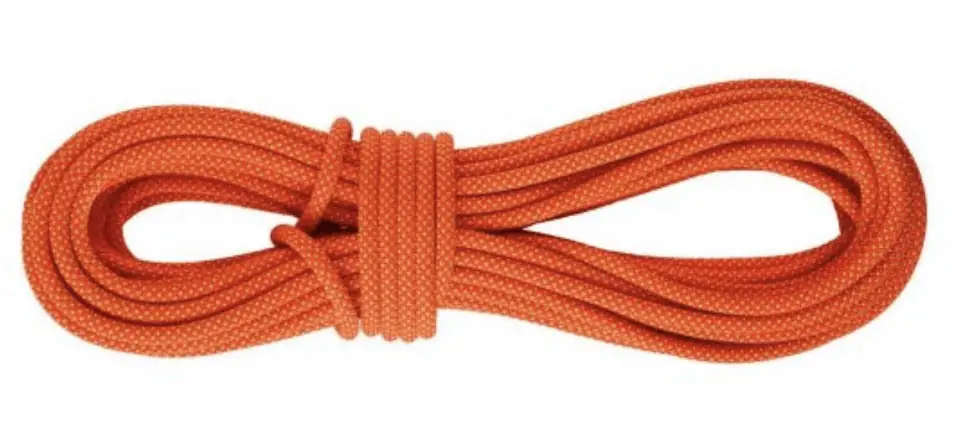
Price: $210 per 60 meters
Pros:
- Good width for glacier travel
- Variety of length options
- Dynamic features allow it to be used as a belay line
Cons:
- Heavier despite its width
- Dynamic features may make it harder to perform a glacier rescue with
Verdict
The Photon is a quality rope from Sterling, who have been in the business for more than a quarter of a century and make some of the best ropes on the market.
At just 7.8mm, this half-and-twin rope is light enough to make it perfect for glacier travel. Additionally, the variety of length choices that Sterling offers (30, 40, 50, 60, 70, and 80-meter options) allow you to choose what you want from this rope.
Do you want to get a 40-meter length for only glacier travel? Do you want to extend the rope to 70 meters so that it can be used for easier alpine pitches? With the Photon, you have the option to do either of these things.
Combined with the ropes durable sheath and dry treatment, the Proton gives you more than enough features to work with.
However, there are a couple of things about it that kept it from winning the number one spot. First of all, the dynamic features of the rope will make it harder to use during a crevasse rescue. Secondly, the Photon (despite what its name would suggest) is heavier than both the Rando and the RAD, coming in at 41 grams per meter.
That’s not a huge amount of weight, but it can become a factor over the course of a full day. Still, though, the Photon remains a good, quality option that comes at a reasonable price.
Best for Multipurpose Uses: Mammut 8.7mm Alpine
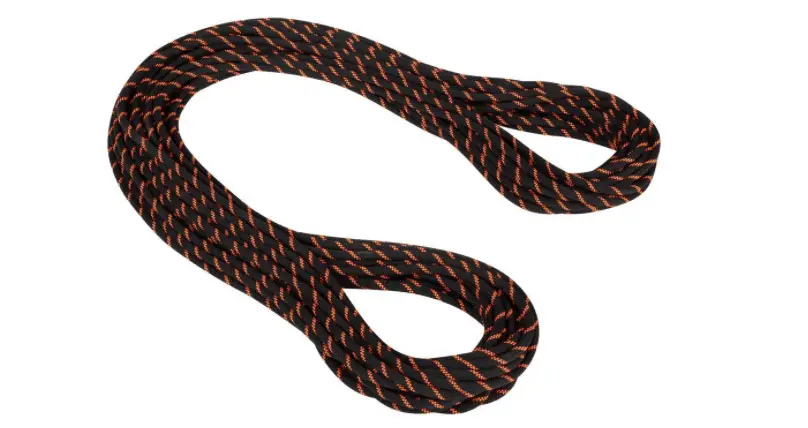
Price: $270 per 60 meters
Pros:
- Can be used as a single, twin, or half rope
- Lightweight for its width
- Dry treatment allows for use in alpine environments
Cons:
- Wider than necessary for glacier travel
- Dynamic features may make it harder to perform a glacier rescue with
Verdict
Sometimes, you need a piece of equipment that’s going to perform well in all kinds of scenarios. The two highest rated ropes on this list— the Rando and the RAD— are specialists. They perform one job, and they perform it really, really well.
Only having one job, however, means that you tend to not be as good at everything else.
A lot of the times, you’re going to need your rope to do more than just keep you safe when you cross a glacier. There are going to be alpine pitches, snow gullies, or ice faces that you need to protect yourself on.
If that’s the case, the Mammut Alpine is the perfect rope for the job. At 8.7mm, this rope is about as thin as you can get for a single rope, while still having the necessary durability and dry treatment to perform well in the alpine. This allows you to save weight while travelling and glacier crossing, while still having enough strength to secure yourself if you need a catch.
Of course, the general-purpose abilities of this rope mean that it won’t perform as well on any specific task. When compared with the Rando, for example, it’s going to be heavier, longer, and harder to perform a crevasse rescue with.
If you’re summiting a less technical objective where glacier protection is all you need, go with the Rando. If, however, you need your rope to do a little bit more for you, the Alpine is one of the best choices out there, while still being a good rope for glacier walking.
